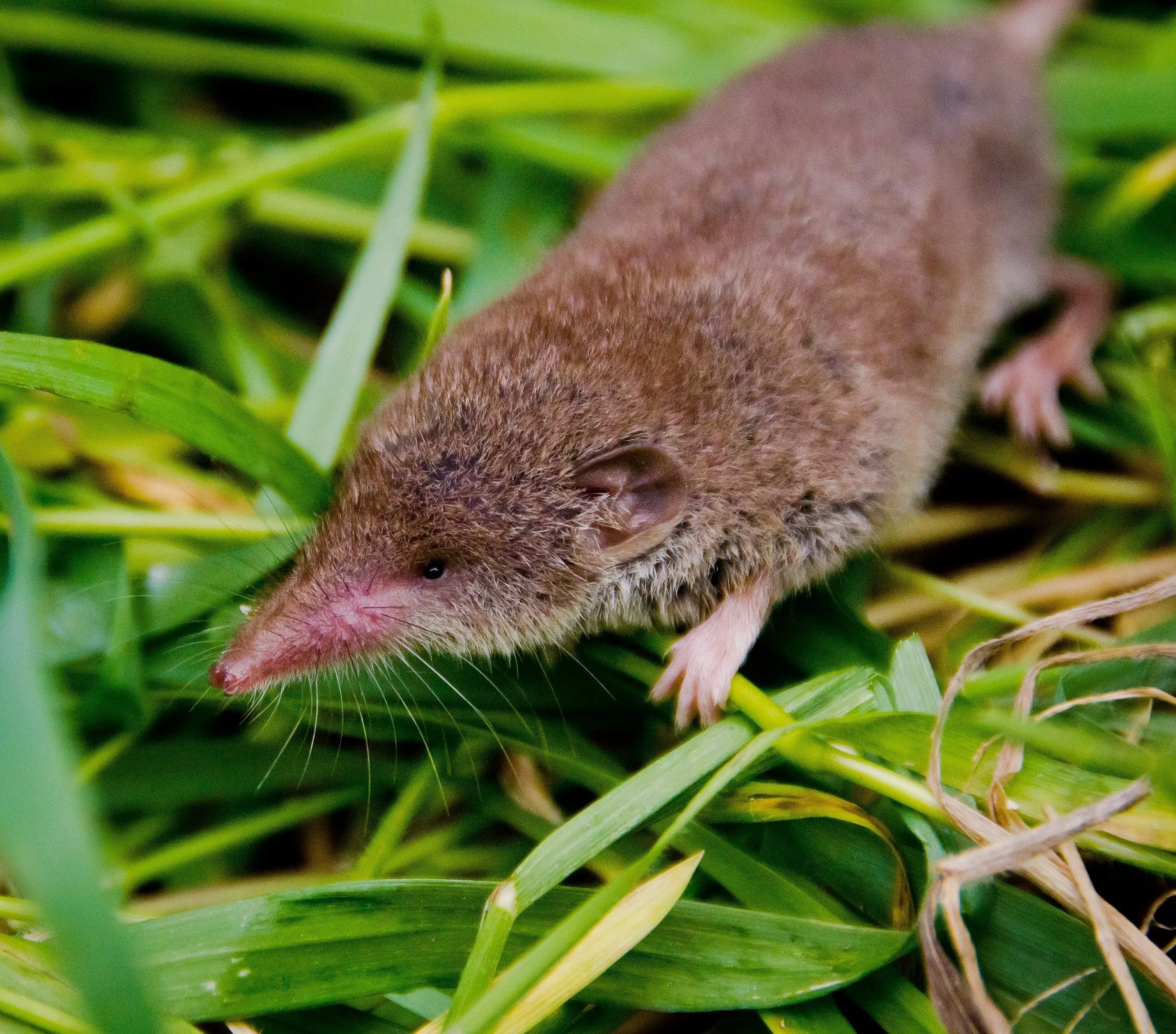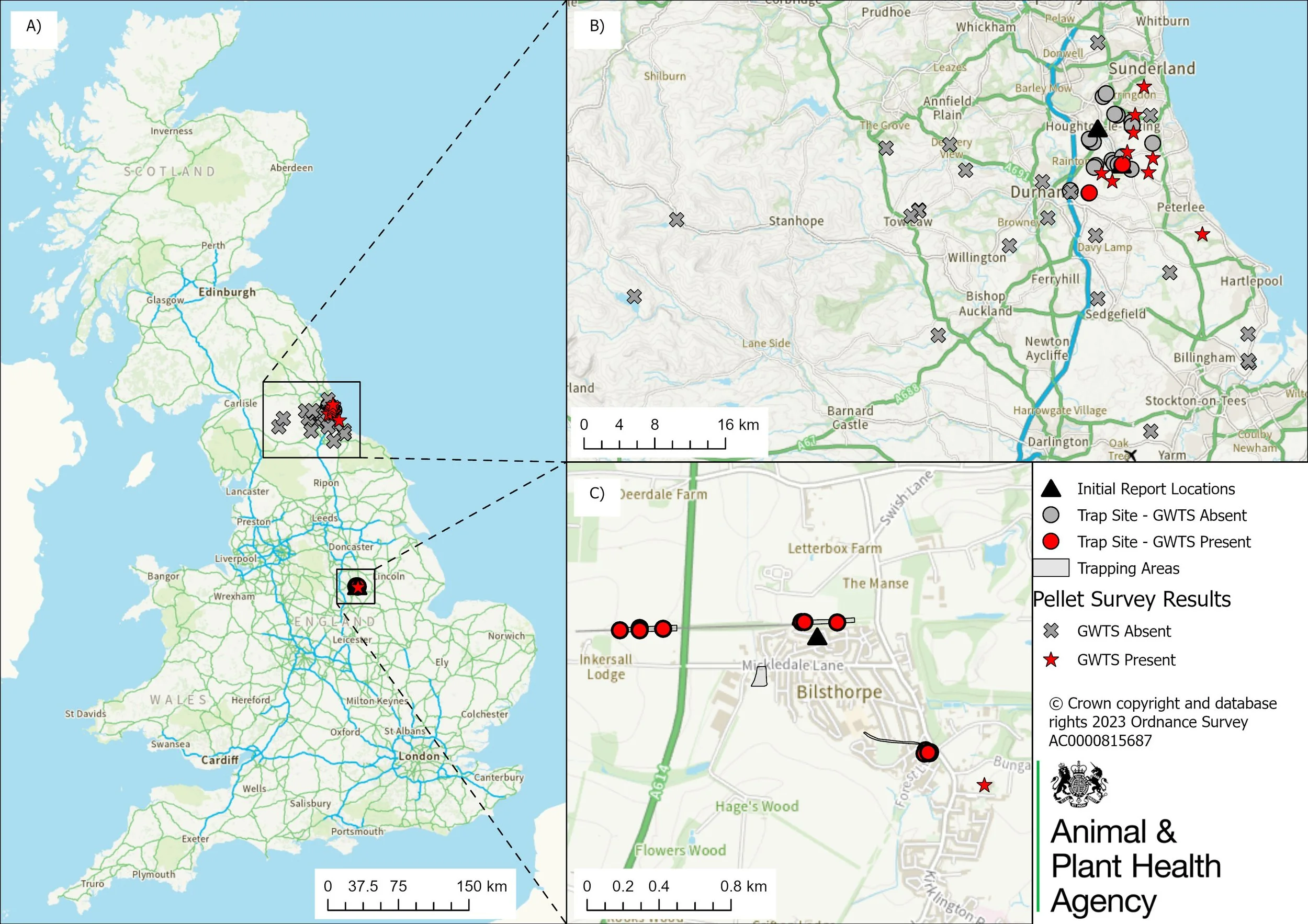Citizen scientists play vital role in ongoing investigation to map the spread of non-native shrew
Greater white-toothed shrew by Ruth Carden
The Mammal Society has released a new map of confirmed greater white-toothed shrew (GWTS) records in time for Invasive Species Week (20th-26th May 2024), showing the extent of two known populations in County Durham and Nottinghamshire, the former covering something in the region of 90km².
It is 18 months since the non-native greater white-toothed shrew (GWTS) was proven to be present in Britain, when one was brought in by a cat (named Jeff) belonging to a Sunderland-based Mammal Society supporter in 2021.
Mammalogists are concerned that GWTS could displace our native small mammal species and impact habitats and biodiversity, as they have done in Ireland since being discovered there in 2007.
Most at risk is Britain’s smallest mammal – the pygmy shrew – which has declined dramatically in Ireland as a result of the GWTS.
The Mammal Society’s 'Searching for Shrews' project, launched 18 months ago, has involved a nationwide search for signs of GWTS by local mammal groups and volunteers. The project aims to identify where in the country GWTS are present, and monitor the presence and abundance of native small mammals in order to gain early warning signs of any impact which GWTS have on ecosystems.
Since shrews are difficult to survey for, the 'Searching for Shrews' project (in partnership with Barn Owl Trust) encourages volunteer citizen scientists to analyse barn owl pellets collected from sites all around the UK. Owls regurgitate the indigestible fur and bone of their prey, making it easy for volunteers to find and identify the jawbones and skulls of the small mammals which they consume, including the GWTS. All three of our native shrew species (pygmy shrew, common shrew, and water shrew) have red-tipped teeth due to iron deposited in the enamel, but GWTS, as the name suggests, do not.
Pygmy shrew vs greater white-toothed shrew jaws by David Tosh
So far, more than 500 volunteers around the UK have signed up to help with the project by dissecting pellets in their spare time (using guide resources provided by the Mammal Society). Already, more than 350 pellets have been analysed by volunteers (including classes of schoolchildren in England, Scotland and Wales), resulting in around 2500 records of small mammals amongst the prey animals in the pellets.
GWTS have so far been confirmed to be present in two locations – County Durham and Nottinghamshire - and intensive surveying has been undertaken around these sites to track the extent of this population and to allow the rate of expansion of their territory to be monitored over time. Surveying in these areas has involved intensive owl pellet analysis, small mammal trapping, and some bio-acoustic monitoring. GWTS emit sounds that are different from those made by native small mammals, and the analysis of sound recordings taken in hedgerows and areas of long grass could become an important survey technique to identify if they are present where owls are less active or pellets cannot be obtained.
Map of the distribution of the greater white-toothed shrew
In sites where GWTS have been recorded, there have not yet been signs of native small mammals being displaced, however it is unknown at this stage how long GWTS have been present in these landscapes, and ongoing monitoring is essential to ascertain the impact (if any) that they have on the ecosystem.
In one site in an open area in suburban Sunderland, GWTS were by far the most common prey animal found in the owl pellets – an extraordinary result, as field voles are usually the most common. This suggests that regardless of their impact on other species in the ecosystem, GWTS become very prevalent in areas where they are established.
To help in the search for the GWTS this Invasive Species Week and beyond, anyone can volunteer to carry out owl pellet dissection with the Mammal Society’s 'Searching for Shrews' project. Volunteers receive sanitized pellets alongside guides and resources with identification charts for the different mammals that could be found in the owl pellets. In addition, citizen scientists are recommended to send in barn owl pellets for the project if they have access to any, but should not disturb roosts to obtain them.
School children dissecting owl pellets at Gairloch High School
“The world of small mammals is often unseen and under-monitored, despite the essential role that small mammals play in balanced ecosystems as prey, predators, ecosystem engineers, and seed dispersers”, said Matt Larsen-Daw, CEO of the Mammal Society. “With this project, we have a rare opportunity to track an emerging ecological issue in real-time and gather insight that can inform conservation action before it is too late to prevent a catastrophic loss of our important native small mammals. Anyone can get involved in this real-time investigation, whether by monitoring their local small mammals, collecting and sending in owl pellets, or analysing the contents of owl pellets themselves.”
Further notes
The Mammal Society is a registered charity founded in 1954 and devoted to promoting and supporting the conservation of native mammals across the British Isles and Ireland. www.mammalsociety.org.uk
Mammal Society’s Searching for Shrews project: Searching for Shrews — Mammal Society
Invasive Species Week (20th-26th May 2024) is an annual week of awareness raising and events to help prevent the spread, and reduce the harmful impacts, of invasive non-native plants and animals. Invasive Species Week is coordinated by the Great Britain Non-Native Species Secretariat (NNSS). Invasive Species Week » NNSS (nonnativespecies.org)
Species are considered ‘invasive’ if they are non-native and can cause risk to ecosystems or people. Species may be non-native but pose no threat, and are then not described as invasive.
Shrews are insectivores that feed mainly on invertebrates and have to eat constantly day and night to keep up their energy levels. Our native shrews play an important role in controlling flying insect populations and cycling nutrients.
The Searching for Shrews project is being run in collaboration with The Barn Owl Trust: https://www.barnowltrust.org.uk/
For more information, a media pack, or press enquiries contact Alana Scott, Communications Officer at media@themammalsociety.org.




